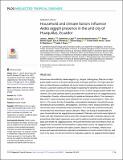Household and climate factors influence Aedes aegypti presence in the arid city of Huaquillas, Ecuador
Abstract
Arboviruses transmitted by Aedes aegypti (e.g., dengue, chikungunya, Zika) are of major public health concern on the arid coastal border of Ecuador and Peru. This high transit border is a critical disease surveillance site due to human movement-associated risk of transmission. Local level studies are thus integral to capturing the dynamics and distribution of vector populations and social-ecological drivers of risk, to inform targeted public health interventions. Our study examines factors associated with household-level Ae. aegypti presence in Huaquillas, Ecuador, while accounting for spatial and temporal effects. From January to May of 2017, adult mosquitoes were collected from a cohort of households (n = 63) in clusters (n = 10), across the city of Huaquillas, using aspirator backpacks. Household surveys describing housing conditions, demographics, economics, travel, disease prevention, and city services were conducted by local enumerators. This study was conducted during the normal arbovirus transmission season (January-May), but during an exceptionally dry year. Household level Ae. aegypti presence peaked in February, and counts were highest in weeks with high temperatures and a week after increased rainfall. Univariate analyses with proportional odds logistic regression were used to explore household social-ecological variables and female Ae. aegypti presence. We found that homes were more likely to have Ae. aegypti when households had interruptions in piped water service. Ae. aegypti presence was less likely in households with septic systems. Based on our findings, infrastructure access and seasonal climate are important considerations for vector control in this city, and even in dry years, the arid environment of Huaquillas supports Ae. aegypti breeding habitat.
Citation
Martin , J L , Lippi , C A , Stewart-Ibarra , A M , Ayala , E B , Mordecai , E A , Sippy , R , Heras , F H , Blackburn , J K & Ryan , S J 2021 , ' Household and climate factors influence Aedes aegypti presence in the arid city of Huaquillas, Ecuador ' , PLoS Neglected Tropical Diseases , vol. 15 , no. 11 , e0009931 . https://doi.org/10.1371/journal.pntd.0009931
Publication
PLoS Neglected Tropical Diseases
Status
Peer reviewed
ISSN
1935-2735Type
Journal article
Description
Funding: This study was funded by NSF EEID DEB 1518681 to SJR, EAM, AMS. EAM was also supported by NIH R35GM133439, NSF DEB-2011147, the Terman Award, the Helman Faculty Fellowship, and the Stanford Center for Innovation in Global Health.Collections
Items in the St Andrews Research Repository are protected by copyright, with all rights reserved, unless otherwise indicated.

